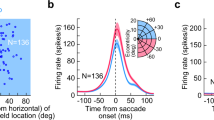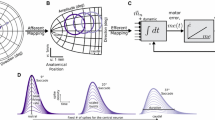Abstract
Recently, we found evidence that the activity of neurons in the deep layers of the monkey superior colliculus (SC) is modulated by initial eye position (gain fields). In this paper, we propose a quantitative model of the motor SC which incorporates these new findings. Inputs to the motor map represent the desired eye displacement vector (motor error), as well as initial eye position. A unit's activity in the motor map is described by multiplying a weak linear eye position sensitivity with a gaussian tuning to motor error. The motor map projects to several sets of output neurons, representing the coordinates of the desired eye displacement vector, the desired eye position in the head, and the three-dimensional ocular rotation axis for saccades in Listing's plane, respectively. All these signals have been hypothesized in the literature to drive the saccade burst generator. We show that these signals can be extracted from the motor map by a linear weighting of the population activity. The saccadic system may employ all coding strategies in parallel to ensure high spatial accuracy in many complex sensorimotor tasks, such as orienting to multimodal stimuli.
Similar content being viewed by others
References
Albano JE, Wurtz RH (1982) Deficits in eye position following ablation of monkey superior colliculus, pretectum, and posterior-medial thalamus. J Neurophysiol 48:318–337
Andersen RA, Essick GK, Siegel RM (1985) Encoding of spatial location by posterior parietal neurons. Science 230:456–458
Andersen RA, Bracewell RM, Barash S, Gnadt JW, Fogassi L (1990) Eye position effects on visual, memory, and saccade-related activity in areas LIP and 7a of macaque. J Neurosci 10:1176–1196
Duhamel J-R, Colby CL, Goldberg ME (1992) The updating of the representation of visual space in parietal cortex by intended eye movements. Science 255:90–92
Goldberg ME, Bruce CJ (1990) Primate frontal eye fields. III. Maintenance of a spatially accurate saccade signal. J Neurophysiol 64:489–508
Hartwich-Young R, Nelson JS, Sparks DL (1990) The perihypoglossal projection to the superior colliculus in the rhesus monkey. Visual Neurosci 4:29–42
Hepp K (1990) On Listing's law. Commun Math Phys 132:285–292
Hepp K, Van Opstal AJ, Straumann D, Hess BJM, Henn V (1993) Monkey superior colliculus represents rapid eye movements in a two-dimensional motor map. J Neurophysiol 69:965–979
Jay MF, Sparks DL (1987) Sensorimotor integration in the primate superior colliculus. II. Coordinates of auditory signals. J Neurophysiol 57:35–55
Jürgens R, Becker W, Kornhuber HH (1981) Natural and drug-induced variations of velocity and duration of human saccadic eye movements: evidence for a control of the neural pulse generator by local feedback. Biol Cybern 39:87–96
Keating EG, Kenney DV, Gooley SG, Pratt SE, McGillis SL (1986) Targeting errors and reduced oculomotor range following ablations of the superior colliculus or pretectum/thalamus. Behav Brain Res 22:191–210
Lee C, Rohrer WH, Sparks DL (1988) Population coding of saccadic eye movements by neurons in the superior colliculus. Nature 332:357–360
McIlwain JT (1982) Lateral spread of neural excitation during microstimulation in the intermediate gray layer of cat's superior colliculus. J Neurophysiol 47:167–178
McIlwain JT (1986) Effects of eye position of saccades evoked electrically from superior colliculus of alert cats. J Neurophysiol 55:97–112
Ottes FP, Van Gisbergen JAM, Eggermont JJ (1986) Visuomotor fields of the superior colliculus: a quantitative model. Vision Res 26:857–873
Peck CK (1986) Eye position signals in cat superior colliculus. Exp Brain Res 61:447–450
Peck CK, Baro JA, Warder SM (1995) Effects of eye position on saccadic eye movements and on the neuronal responses to auditory and visual stimuli in cat superior colliculus. Exp Brain Res (in press)
Poggio T (1990) A theory of how the brain might work. Cold Spring Harbor Symp Quant Biol 55:899–910
Poggio T, Girosy F (1990) Regularization algorithms for learning that are equivalent to multilayer networks. Science 247:978–982
Pouget A, Sejnowski TJ (1995) Spatial representations in the parietal cortex may use basis functions. NIPS Conf Proc, Vol 7 (in press)
Robinson DA (1972) Eye movements evoked by collicular stimulation in the alert monkey. Vision Res 12:1795–1808
Robinson DA (1975) Oculomotor control signals. In: Lennerstrand G, Bach-y-Rita P (eds) Basic mechanisms of ocular motility and their clinical implications. Pergamon Press, Oxford, pp 337–374
Roucoux A, Crommelinck M (1976) Eye movements evoked by superior colliculus stimulation in the alert cat. Brain Res 106:349–363
Schiller PH, Stryker M (1972) Single-unit recordings and stimulation in superior colliculus of the alert rhesus monkey. J Neurophysiol. 35:915–924
Schnabolk C, Raphan T (1994) Modelling three-dimensional velocityto-position transformation in oculomotor control. J Neurophysiol 71:623–638
Scudder CA (1988) A new local feedback model of the saccadic burst generator. J Neurophysiol 59:1455–1475
Segraves MA, Goldberg ME (1984) Initial orbital position affects the trajectories of large saccades evoked by electrical stimulation of the monkey superior coolliculus. Soc Neuorsci Abstr 10:389
Sparks DL, Mays LE (1980) Movement fields of saccade-related burst neurons in the monkey superior colliculus. Brain Res 190:39–50
Sparks DL, Mays LE (1983) Spatial localization of saccade targets. I. Compensation for stimulation-induced perturbations in eye position. J Neurophysiol 49:45–63
Sparks DL, Mays LE (1990) Signal transformations required for the generation of saccadic eye movements. Annu Rev Neurosci 13:309–336
Stein BE, Meredith MA (1993) The merging of the senses. MIT Press, Cambridge, Mass
Tweed D, Vilis T (1987) Implications of rotational kinematics for the oculomotor system in three dimensions. J Neurophysiol 58:832–849
Tweed D, Vilis T (1990a) Geometric relations of eye position and velocity vectors during saccades. Vision Res 30:111–127
Tweed D, Vilis T (1990b) The superior colliculus and spatiotemporal translation in the saccadic system. Neural Networks 3:75–86
Tweed D, Misslisch H, Fetter M (1994) Testing models of the oculomotor velocity-to-position transformation. J Neurophysiol 72:1425–1429
Van Gisbergen JAM, Van Opstal AJ, Tax AAM (1987) A model of the ollicular motor map based on vector summation. Neuroscience 7:555–567
Van Opstal AJ (1993a) Representation of eye position in three dimensions. In: Berthoz A (ed) Multisensory control of movement. Oxford University Press, Oxford, pp 27–41
Van Opstal AJ (1993b) Experimental test of two models for the role of monkey superior colliculus in 3D saccade generation. In: Berthoz A (eds) Multisensory control of movement. Oxford University Press, Oxford, pp 240–254
Van Opstal AJ (1994) Nonlinearities in the saccadic system and efferent feedback to the collicular motor map. In: Delgado-García J-M, Vidal P, Godeaux E (eds) Information processing underlying gaze control. Pergamon Press, Oxford, pp 139–149
Van Opstal AJ, Hepp K (1995) Motor map of monkey superior colliculus may encode eye motor error, target position relative to the head, or both. Fourth IBRD World Conf Neurosci Abstr, pp. 49
Van Opstal AJ, Kappen H (1993) A two-dimensional ensemble coding model of spatial-temporal transformation of saccades in monkey superior colliculus. Network 4:19–38
Van Opstal AJ, Hepp K, Suzuki Y, Henn V (1995) Influence of eye position on activity in monkey superior colliculus. J Neurophysiol (in press)
Van Opstal AJ, Van Gisbergen JAM, Smit AC (1990) Comparison of saccades evoked by visual stimulation and collicular electrical stimulation in the alert monkey. Exp Brain Res 79:299–312
Van Opstal AJ, Hepp K, Hess BJM, Straumann D, Henn V (1991) Two-rather than three-dimensional representation of saccades in monkey superior colliculus. Science 252:1313–1315
Waitzman DM, Ma TP, Optican LM, Wurtz RH (1991) Superior colliculus neurons mediate the dynamic characteristics of saccades. J Neurophysiol 66:1716–1737
Zipser D, Andersen RA (1988) A back-propagation programmed network that simulates response properties of a subset of posterior parietal neurons. Nature 331:679–684
Author information
Authors and Affiliations
Rights and permissions
About this article
Cite this article
Van Opstal, A.J., Hepp, K. A novel interpretation for the collicular role in saccade generation. Biol. Cybern. 73, 431–445 (1995). https://doi.org/10.1007/BF00201478
Received:
Accepted:
Issue Date:
DOI: https://doi.org/10.1007/BF00201478




